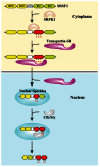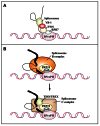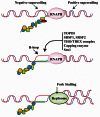Pre-mRNA processing factors meet the DNA damage response
- PMID: 23761808
- PMCID: PMC3674313
- DOI: 10.3389/fgene.2013.00102
Pre-mRNA processing factors meet the DNA damage response
Abstract
It is well-known that DNA-damaging agents induce genome instability, but only recently have we begun to appreciate that chromosomes are fragile per se and frequently subject to DNA breakage. DNA replication further magnifies such fragility, because it leads to accumulation of single-stranded DNA. Recent findings suggest that chromosome fragility is similarly increased during transcription. Transcripts produced by RNA polymerase II (RNAPII) are subject to multiple processing steps, including maturation of 5' and 3' ends and splicing, followed by transport to the cytoplasm. RNA maturation starts on nascent transcripts and is mediated by a number of diverse proteins and ribonucleoprotein particles some of which are recruited cotranscriptionally through interactions with the carboxy-terminal domain of RNAPII. This coupling is thought to maximize efficiency of pre-mRNA maturation and directly impacts the choice of alternative splice sites. Mounting evidence suggests that lack of coordination among different RNA maturation steps, by perturbing the interaction of nascent transcripts with the DNA template, has deleterious effects on genome stability. Thus, in the absence of proper surveillance mechanisms, transcription could be a major source of DNA damage in cancer. Recent high-throughput screenings in human cells and budding yeast have identified several factors implicated in RNA metabolism that are targets of DNA damage checkpoint kinases: ATM (ataxia telangiectasia mutated) and ATR (ATM-Rad3 related) (Tel1 and Mec1 in budding yeast, respectively). Moreover, inactivation of various RNA processing factors induces accumulation of γH2AX foci, an early sign of DNA damage. Thus, a complex network is emerging that links DNA repair and RNA metabolism. In this review we provide a comprehensive overview of the role played by pre-mRNA processing factors in the cell response to DNA damage and in the maintenance of genome stability.
Keywords: DNA damage response; RNA binding proteins; checkpoint kinases; pre-mRNA processing; splicing.
Figures




Similar articles
-
Requirement of the Mre11 complex and exonuclease 1 for activation of the Mec1 signaling pathway.Mol Cell Biol. 2004 Nov;24(22):10016-25. doi: 10.1128/MCB.24.22.10016-10025.2004. Mol Cell Biol. 2004. PMID: 15509802 Free PMC article.
-
ATM and ATR pathways signal alternative splicing of Drosophila TAF1 pre-mRNA in response to DNA damage.Mol Cell Biol. 2006 Dec;26(24):9256-67. doi: 10.1128/MCB.01125-06. Epub 2006 Oct 9. Mol Cell Biol. 2006. PMID: 17030624 Free PMC article.
-
Two separate pathways regulate protein stability of ATM/ATR-related protein kinases Mec1 and Tel1 in budding yeast.PLoS Genet. 2017 Aug 21;13(8):e1006873. doi: 10.1371/journal.pgen.1006873. eCollection 2017 Aug. PLoS Genet. 2017. PMID: 28827813 Free PMC article.
-
Interplays between ATM/Tel1 and ATR/Mec1 in sensing and signaling DNA double-strand breaks.DNA Repair (Amst). 2013 Oct;12(10):791-9. doi: 10.1016/j.dnarep.2013.07.009. Epub 2013 Aug 13. DNA Repair (Amst). 2013. PMID: 23953933 Review.
-
Mec1/ATR, the Program Manager of Nucleic Acids Inc.Genes (Basel). 2016 Dec 28;8(1):10. doi: 10.3390/genes8010010. Genes (Basel). 2016. PMID: 28036033 Free PMC article. Review.
Cited by
-
Connections between 3' end processing and DNA damage response: Ten years later.Wiley Interdiscip Rev RNA. 2020 Mar;11(2):e1571. doi: 10.1002/wrna.1571. Epub 2019 Oct 28. Wiley Interdiscip Rev RNA. 2020. PMID: 31657151 Free PMC article. Review.
-
Co-Expression Network Analysis of Spleen Transcriptome in Rock Bream (Oplegnathus fasciatus) Naturally Infected with Rock Bream Iridovirus (RBIV).Int J Mol Sci. 2020 Mar 2;21(5):1707. doi: 10.3390/ijms21051707. Int J Mol Sci. 2020. PMID: 32131541 Free PMC article.
-
DNA damage and repair in plants - from models to crops.Front Plant Sci. 2015 Oct 23;6:885. doi: 10.3389/fpls.2015.00885. eCollection 2015. Front Plant Sci. 2015. PMID: 26557130 Free PMC article. Review.
-
Regulation and Modulation of Human DNA Polymerase δ Activity and Function.Genes (Basel). 2017 Jul 24;8(7):190. doi: 10.3390/genes8070190. Genes (Basel). 2017. PMID: 28737709 Free PMC article. Review.
-
On the road with WRAP53β: guardian of Cajal bodies and genome integrity.Front Genet. 2015 Mar 24;6:91. doi: 10.3389/fgene.2015.00091. eCollection 2015. Front Genet. 2015. PMID: 25852739 Free PMC article. Review.
References
-
- Baranello L., Bertozzi D., Fogli M. V., Pommier Y., Capranico G. (2010). DNA topoisomerase I inhibition by camptothecin induces escape of RNA polymerase II from promoter-proximal pause site, antisense transcription and histone acetylation at the human HIF-1alpha gene locus. Nucleic Acids Res. 38 159–171 10.1093/nar/gkp817 - DOI - PMC - PubMed
LinkOut - more resources
Full Text Sources
Other Literature Sources
Molecular Biology Databases
Research Materials
Miscellaneous

